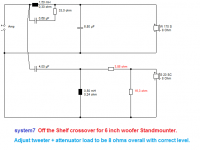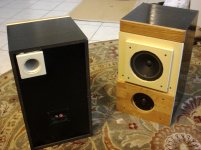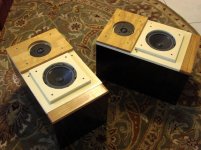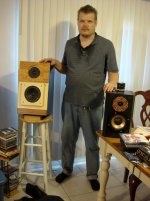When your audio project gives you grief, don't give up, get even.
6" paper cone woofer 1 1/8" soft dome tweeter DIY audio project - YouTube
6" paper cone woofer 1 1/8" soft dome tweeter DIY audio project - YouTube
Very enjoyable musical interlude, my friend.
Strong in the force have I grown since I last spoke with you.
You need a 5kHz notch with a 6 inch woofer. This'll do.
But tell us more of your Zobel. I've never had much luck with them in parallel jobbies.
Strong in the force have I grown since I last spoke with you.
You need a 5kHz notch with a 6 inch woofer. This'll do.
But tell us more of your Zobel. I've never had much luck with them in parallel jobbies.
Attachments
Thanks, system7. These speakers surf on the phase-wave, there's nothing stopping them. You have to realize a woofer is going into a crossover pre-loaded in the inductive phase, so it can not survive an L-R filter with dignity, L-R relying heavily on the inductor to do the job. And a traditional Zobel kills the output. But there are ways. I've done progress in my understanding about filters during the past year. I bought my first planer recently and will begin my first cabinet from scratch. I'm also writing a book on how people can tweak/build 2-way speakers.
What have you been doing?
What have you been doing?
What have I been doing? Mainly looking into why every good design does something better, and something else worse! There are some laws of Physics that make everything a trade-off. Nevertheless, you can do what Steen Duelund calls "Designing to the limits of possibility". It's working WITH the limitations.
Like yourself, I am starting to think that Linkwitz-Riley flat frequency response is not the last word. Flat power delivery may be more important.
Perhaps you prefer to continue via PM though. Dark forces an' all that!
Like yourself, I am starting to think that Linkwitz-Riley flat frequency response is not the last word. Flat power delivery may be more important.
Perhaps you prefer to continue via PM though. Dark forces an' all that!
And here is another taste of good sound, to keep people motivated to not give up on their own projects:
take two: 6" paper cone woofer 1 1/8" soft dome tweeter - YouTube
take two: 6" paper cone woofer 1 1/8" soft dome tweeter - YouTube
And the final, Sandwich Edition. Why complicate it.
take three: 6" paper cone woofer 1 1/8" soft dome tweeter, the final Sandwich Edition - YouTube
take three: 6" paper cone woofer 1 1/8" soft dome tweeter, the final Sandwich Edition - YouTube
The project is now complete. I'm very pleased with the sound. With a bigger box volume than recommended for the woofer, and a wide and deep port, the bass goes all the way down to 20 Hz, and without the swollen, boomy presence around 200 Hz which is found in most speakers you buy in the store. The mid range is clean-sounding and even, and the high end as well. It's all I ever wanted from a pair of 2-way speakers. And they look like they are from the 1920's. Cool.
They began as a functioning pair of Pinnacle PN-8 that I found at GoodWill, a secondhand store selling donated goods. They sounded horrible, the way speakers do. I first sealed the ports from the inside with sheets of plywood and wood glue. Didn't help. The woofer was highly inductive and sounded like crap when I tried to modify the crossover, which originally had a Zobel on it, one that killed the output above 500 Hz with a vengeance. The tweeter was lost, on its own, free floating, playing with a sucky crossover that said "I thought I was an audio engineer, but I give up". From thereon it was a learning process with lots of experimenting. That was two years ago. The woofers ended up in NYC somewhere. A guy wanted them shipped, probably had his own blown.
The hunt for the crossover in my speakers early took me to 0.5 mH and 4 uF for the woofer, a curve of attenuation that sounded good, and one I could visualize in my head. It's a standard 2nd order Butterworth at 3500 Hz for a 8 ohm resistive driver. But because of the induction built in in the woofer, that crossover happens at 2500 Hz, and it has a slightly ringing, harsh tone to it. By putting a 1 ohm resistor in series with the 4 uF, that ringing harshness went away and the crossover point moved upward, to 2750 Hz, or so. That's where the 2nd order Bessel hits for the tweeter, with reversed poles. Because I listen to the speakers at an angle I maximize the in-phase playing at the crossover point, which means a minimum of ghosting between the drivers. There is an iron core inductor for the woofer and an air core inductor for the tweeter. Polyester, polypropylene and paper in oil capacitors.
The wooden material I added is all plywood, including the supporting structures I put inside of the cabinets. It's two layers of white paint and two layers of a clear oil-based coating of an orange brown tint. The frame around the tweeter has just the clear coating. The frames on the baffle are vacuum cleaner guards, in case the speakers will stand on the floor in the future (cabinets turned, tweeter lowest, for best sound). A vacuum cleaner will bump into the frames, not the drivers. I suppose the frames will save the drivers from my cats' claws as well, because the inner edge of the frame is what they will cling on to, I hope. The woofer also sounds cleaner with the frame mounted, less noise of break up around 1500 Hz. The hole for the tweeter was deliberately put off center for a more interesting look. Leaf green screws add to the Florida orange fruit design. And then I painted the entire cabinet in the same clear coating for a shiny orange peel oil look. But that idea came about after I was sloppy with the touching up of the sides of the baffle, streaks running on the sides of the cabinet, so why not paint it all. The inside of the cabinets have seen watered-down wood glue run along all joints, wood glue seeping into all thin gaps.
If you want me to record other styles of material through these wonderful speakers, put your request down here.
They are for sale. Consider that they are 27.5 pounds, 12.5 kg, each, and have to be shipped separately. Or you can drive down to the south peak of Florida and pick them up.
In the video, centered, there is a brown bubble pack containing saw blades for my new jig saw. I have the next project mapped out in my head. Those cabinets I found at GoodWill as well, but with those I will make their narrow side the baffle. You will see.
audiophilers' wet dream - YouTube
They began as a functioning pair of Pinnacle PN-8 that I found at GoodWill, a secondhand store selling donated goods. They sounded horrible, the way speakers do. I first sealed the ports from the inside with sheets of plywood and wood glue. Didn't help. The woofer was highly inductive and sounded like crap when I tried to modify the crossover, which originally had a Zobel on it, one that killed the output above 500 Hz with a vengeance. The tweeter was lost, on its own, free floating, playing with a sucky crossover that said "I thought I was an audio engineer, but I give up". From thereon it was a learning process with lots of experimenting. That was two years ago. The woofers ended up in NYC somewhere. A guy wanted them shipped, probably had his own blown.
The hunt for the crossover in my speakers early took me to 0.5 mH and 4 uF for the woofer, a curve of attenuation that sounded good, and one I could visualize in my head. It's a standard 2nd order Butterworth at 3500 Hz for a 8 ohm resistive driver. But because of the induction built in in the woofer, that crossover happens at 2500 Hz, and it has a slightly ringing, harsh tone to it. By putting a 1 ohm resistor in series with the 4 uF, that ringing harshness went away and the crossover point moved upward, to 2750 Hz, or so. That's where the 2nd order Bessel hits for the tweeter, with reversed poles. Because I listen to the speakers at an angle I maximize the in-phase playing at the crossover point, which means a minimum of ghosting between the drivers. There is an iron core inductor for the woofer and an air core inductor for the tweeter. Polyester, polypropylene and paper in oil capacitors.
The wooden material I added is all plywood, including the supporting structures I put inside of the cabinets. It's two layers of white paint and two layers of a clear oil-based coating of an orange brown tint. The frame around the tweeter has just the clear coating. The frames on the baffle are vacuum cleaner guards, in case the speakers will stand on the floor in the future (cabinets turned, tweeter lowest, for best sound). A vacuum cleaner will bump into the frames, not the drivers. I suppose the frames will save the drivers from my cats' claws as well, because the inner edge of the frame is what they will cling on to, I hope. The woofer also sounds cleaner with the frame mounted, less noise of break up around 1500 Hz. The hole for the tweeter was deliberately put off center for a more interesting look. Leaf green screws add to the Florida orange fruit design. And then I painted the entire cabinet in the same clear coating for a shiny orange peel oil look. But that idea came about after I was sloppy with the touching up of the sides of the baffle, streaks running on the sides of the cabinet, so why not paint it all. The inside of the cabinets have seen watered-down wood glue run along all joints, wood glue seeping into all thin gaps.
If you want me to record other styles of material through these wonderful speakers, put your request down here.
They are for sale. Consider that they are 27.5 pounds, 12.5 kg, each, and have to be shipped separately. Or you can drive down to the south peak of Florida and pick them up.
In the video, centered, there is a brown bubble pack containing saw blades for my new jig saw. I have the next project mapped out in my head. Those cabinets I found at GoodWill as well, but with those I will make their narrow side the baffle. You will see.
audiophilers' wet dream - YouTube
Attachments
- Status
- This old topic is closed. If you want to reopen this topic, contact a moderator using the "Report Post" button.
- Home
- Loudspeakers
- Multi-Way
- Inspiration



